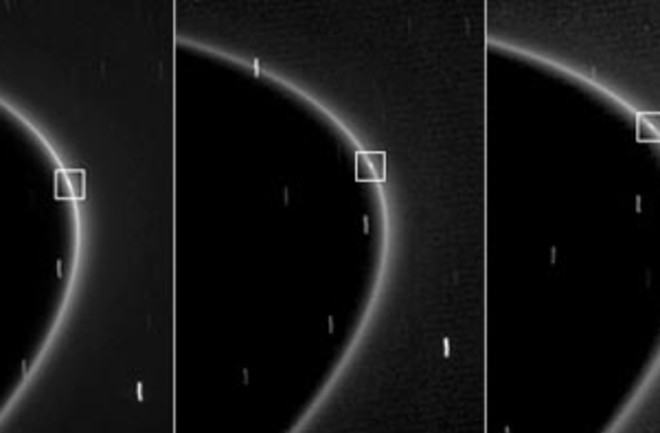The Cassini space probe has detected a tiny moon nestled in one of Saturn's outermost rings, making it the 61st known Saturnian satellite. The moonlet measures only about one-third of a mile in diameter, but researchers say the diminuitive moon is big enough to be the likely source of the dust that forms the ring, thus solving a mystery. Cassini spotted the moonlet as a bright streak of light in the second to last ring from Saturn, which is called the G ring.
"Before Cassini, the G ring was the only dusty ring that was not clearly associated with a known moon, which made it odd," said [Cassini scientist] Matthew Hedman.... "The discovery of this moonlet, together with other Cassini data, should help us make sense of this previously mysterious ring" [CNN].
Researchers say that meteoroids have probably collided with the small moon throughout the solar system's history, sending out sprays of dust to fill up the G ring. Says Hedman:
"Being one of the bigger objects, the moonlet is likely to be hit more often." ... This means the moonlet is probably a significant source of ring material, the scientists say. In the long term, "as this and other objects grind themselves down, it's conceivable they would disappear, and then the G ring would disappear," Hedman noted [National Geographic News].
Cassini's observations, announced in a notice from the International Astronomical Union, revealed that the moonlet moves in a partial "ring arc" that extends about one-sixth of the way around the G ring.
Cassini, which was funded by NASA and the European and Italian space agencies, launched in 1997 and took seven years to make the 934 million-mile (1.5 billion-kilometer) trip to Saturn. Since its arrival, Cassini has been making a looping voyage through the Saturn system and is returning loads of data on the ringed planet and its moons [CNN].
Related Content: Bad Astronomy: Cassini spots a moon, solves a mystery has more on this discovery 80beats: On Saturn’s Moon Titan, It’s Raining Methane 80beats: New Evidence of Hospitable Conditions for Life on Saturn’s Moons 80beats: Geysers From Saturn’s Moon May Indicate Liquid Lakes, and a Chance for Life 80beats: Hydrocarbon Lake on Saturnian Moon May Be a Hotspot for Alien LifeImage: NASA/JPL/Space Science Institute

